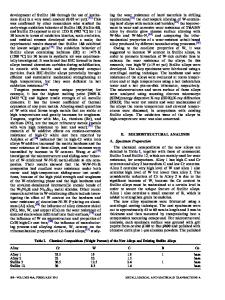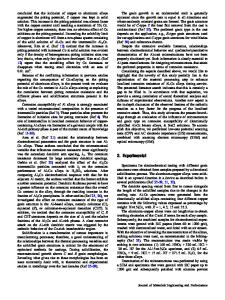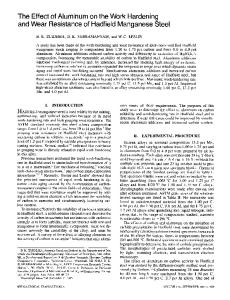Effect of Nanostructuring of Aluminum, Copper, and Alloys on Their Basis Wear for Resistance and Hardness
- PDF / 655,843 Bytes
- 4 Pages / 612 x 792 pts (letter) Page_size
- 52 Downloads / 367 Views
ct of Nanostructuring of Aluminum, Copper, and Alloys on Their Basis Wear for Resistance and Hardness R. A. Apakasheva, *, M. L. Khazina, and S. A. Krasikova aUral
State Mining University, Yekaterinburg, 620144 Russia *e-mail: [email protected]
Received March 2, 2020; revised July 5, 2020; accepted July 7, 2020
Abstract—A comparative study of the wear resistance and hardness of samples of A1100 grade aluminum grade, C11000 grade copper, 518.0 aluminum–magnesium alloy, and C95200 bronze obtained by the metallurgical method without and with nanostructural processing has been studied. Wear resistance of samples of metals and alloys was determined on a four-ball friction machine equipped with a special friction unit. The hardness was tested using the Brinell method on a Zwick/Roell Z050 universal testing machine. Electron and atomic force microscopy were used to determine the type of structure of the samples. It is shown that nanostructuring of these non-ferrous metals and alloys has a significant impact on their resistance to friction wear and hardness. An increase in the wear resistance of samples by 11–28% with a corresponding increase in hardness by a value of 12–15% was found. Keywords: aluminum, copper, non-ferrous metal alloys, nanostructuring, friction, wear resistance, hardness DOI: 10.3103/S1068366620050037
INTRODUCTION A common operating condition that accompanies the operation of machines and mechanisms is the presence of high specific loads and speeds of mutual movement of parts of friction units. The fight against friction losses and wear of moving joints of machines and mechanisms is one of the urgent tasks of modern engineering. In developed countries, significant funds are spent annually on the repair of machinery and equipment. The significance of friction and wear issues for the economy is due to the fact that machines fail due to wear and damage to the friction surfaces of movable joints [1]. Therefore, to ensure the reliability and durability of products of both ordinary and critical applications, materials are required that can withstand harsh operating conditions for a long time. Functional nanostructured metal materials, which, as a rule, have a high level of physicomechanical properties, potentially satisfy such requirements [2–4]. The existing scientific and technical reserve creates the prerequisites for the development of various technologies for producing metal materials with a nanocrystalline structure, including technologies using thermomechanical processing and using liquid-phase methods [3]. Investigations are being carried out in this direction in order to refine the parameters of the process of nanomodification of the structure of a certain metal material, followed by obtaining actual data on its structure and properties to determine the scope of its possible effective application. In this case, the
bulk of publications in the study of the tribotechnical parameters of metallic nanomaterials are related to nanostructured film coatings or to metal matrix composites dispersedly rein
Data Loading...











